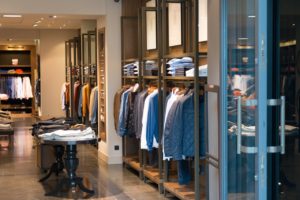There are agencies that exist to predict what people will want to wear in the future, a practice called trend forecasting. They are one of the primary reasons why the seasonal collections for many chain and department stores tend to look very similar. In some cases, different brands end up selling the same design. The collections are often decided well before the actual season and year they are released. Many trend forecasters release their reports around 18 months before the season they are predicting for, or longer, in most cases [1].

The appeal behind these agencies is the peace of mind they give by making it more likely that people will buy a company’s products when they are released. Retailers don’t want to carry products that won’t move and they definitely don’t want to waste time and money getting them made. It is a very sensible and safe way to approach product planning, but narrows the creativity that is often associated with fashion. It is also very expensive. These agencies charge a premium for their crystal ball predictions and their reports can be overwhelming for those who are unfamiliar.

If you are an entrepreneur looking to get into the fashion business or a small brand looking to improve sales, how much stock should you put in these trend reports? It depends on how much effort you are willing to put into constantly adapting your product offerings to fall in line with the forecast guidelines and whether you think the reports actually reflect the demographic and market that your business operates in. It also matters if you have the money to pay these agencies as well. It’s important to ask yourself, do I want to sell a trendy product that’s white hot for a few moments (fidget spinners) OR do I want to see my stuff on every person I come across at the new free range, artisanal donut shop? These questions target different desires and demographics and require different strategies to accomplish. What is trendy for one group can often be “uncool” in another. Understand your niche first before attempting to incorporate what the agencies are calling trendy.
As Fern Seto, a freelance writer for the HighSnobiety blog puts it, “…the idea of what constitutes a “trend” has shifted. It’s no longer about a singular look, but distilling lifestyles and mindsets into marketable concepts” [2]. Assuming that you’ve done your own research on who your market is, I would hope that you have a much better understanding of the “lifestyles and mindsets” of your target customers than an agency located far away from where your business is primarily located. If you’re strictly an online business, this still holds true. A target market of “everyone” does little to help you plan and focus your marketing and sales efforts.

Thankfully, for smaller brands keen on keeping up with the “trends”, manufacturers and suppliers will often move to the tune set by much larger companies. They will adjust what they produce to fall in line with the trend reports just by the demand pressure from the bigger brands anyway. It’s very common for manufacturers to offer generic versions of the trendier styles seen in chain and department stores.
For entrepreneurs and smaller brands, it makes more sense to put focus on refining what your own brand offers and innovate within your category before attempting to branch out into other areas. Don’t focus so heavily on trend reports and on trying to keep up with the “big” guys. It’s like chasing cats. The business of fashion is volatile since products depend on season and can have short lifetimes [1]. If anything, the tide is turning on the “big” guys and heading to a smaller, more sustainable, community oriented direction. –
Resources & Citations:
The London College of Fashion offers a 6 week, online course for £350 (~$457) on fashion trend forecasting.
Pantone (yes, the paint folks) offer a series of helpful (and expensive) color forecast products for fashion and design.

Adu Makan
Freelance Writer


It's hopier and changier horse hockey. That's all.Each of them has some mental issue going on.Pelosi's botox has pickled her brain.As the
Good afternoon my Name is Antonio and I leave in Padua (Italy) Our satisfaction for argouments I read ours commets We invite you one see Can I post this page on my site Forum ?
“ZgÅ‚osiÅ‚em PaÅ„ski wpis do usuniÄ™cia. Jest Pan w moralnym szambie.”Masz jakieÅ› wielkoÅ›ciowe urojenia, cudaku (ja z kolei twój, pożal siÄ™ Boże, ‘komentarz’ zgÅ‚osiÅ‚em do zwiniÄ™cia)ENTEFUHRER 29913151 | 04.09.2012 01:07
Why there is no more "List view" in the New Tab page for most visited sites??Please, take the List view back! I don't like the mini-screen preview…
develop elements of surprise and suspense in…any form of writing.ideas are problems waiting to be solved. they are difficulties to conquer, snares to escape, or treasures to win. good writing begins with a series of fascinating or entertaining or important ideas. it then weaves those ideas into…
okay, so that explains everything. and it’s really cool that u’re doing sth like this;)so, about u’re mustache.. u look different. just different and this is my opinion;)and ofc, good luck in Kussamo!
Runner Leana · I am sooooo happy to see you checking in! I'm glad to hear you are happy with how your day went. Take care, I totally understand needing to step back. Hope to hear more from you soon!
He, grappig, zo'n blik heb ik in mijn webwinkeltje, maar dan niet geschilderd. Geeft wel een mooi resultaat vind ik, dat grijs/wit. Misschien moet ik hem maar zelf houden. Ik vind hem super zo!Lieve groetjes, Peet.
Speaking of Amélie, try Dirty Pretty Things, also with Audrey Tautou. Now there’s a movie I could watch over and over 4 times over and over! Stay away from TV; it’ll rot your brain. I could name about 40 jobs I’ve had, but that would be really boring.
People love to hate liberal celebrities who work for causes. Personally, I think people cannot stand the idea that someone is rich and good looking and decent and humane. They fabricate reasons to hate them out of jealousy.
We all bring something new and different to our stories. For me, I try as much as possible to go with a scenario that’s not your everyday fare. Keep working on getting your book. You’re doing the right thing.
HermitLion, true it's just set in the Gulf War so I skipped it. If we go back to the Gulf War, the picture isn't quite as grim, but still mostly negative.Edgar, yes the Israeli film industry is pretty bad. Maybe even worse. It's not a precedent though, it's the same thing. Ditto in England. First world countries defaming the fight against terrorism.noboat1, it could be given away for free too.I would still like to see an experiment in which the producer of a major news network is offered an exclusive on a 9/11 type attack by terrorists on the condition that he doesn't inform the government.
I think you’ve misread the context in which this phrase was used. Then again perhaps I have. All I see in that comment was that the steak sandwich was simple, and honest. It seemed to make no reference or allusion to the area in which the food came from nor any connection between simplicity and honesty or your inference that less simplicity implies dishonesty.Maybe take a chill pill, have a coke and a smile 🙂
Har ikke Venstre stor oppslutning i Oslo, da ? РHvor Ola Elvestuen, Trine Skei Grande, Abid Radja og Borghild Tenden forfekter Venstres saker p̴ en positiv m̴te.
Youre so cool! I dont suppose Ive read anything like this before. So good to search out someone with some unique thoughts on this subject. realy thanks for starting this up. this website is one thing that’s wanted on the net, somebody with somewhat originality. helpful job for bringing something new to the web!
Religious nuts justify their positions by claiming some kind of weak neutrality, when in fact what they are doing is breaking the governments ability to be secular.“In God We Trust” should be removed from any and every government related establishment. They try and claim it’s part of out heritage and not religious. Really, because it has the word “GOD” in it, I say that makes it pretty damn religious.
Thanks Samantha, I am flattered by your words!Very happy to know that you are following me, and that you enjoyed this selection of photos. Thanks and all the best to you too!
Nice blog here! Also your website loads up fast! What host are you using? Can I get your affiliate link to your host? I wish my site loaded up as quickly as yours lol
“Additionally, questions ought to be asked of why the public are so ready to see Muslim males extradited for crimes not committed on US soil, but are in starkly contrasting uproar about the potential extradition of men such as Gary McKinnon and Richard O’Dwyer.”Because they’re racist?
Lucas disse:A informação não procede. O Tribunal só anulou as escutas originadas do telefone do delegado Jordão, quanto aos demais réus o processo segue tramitando normalmente na Primeira Vara Criminal de Foz do Iguaçu. É isso.
Before it’s News is a link, but not really.. They are a syndication service, nothing more… They don’t write anything, if you’re registered with them, when you post, they pick up your feed and re-post it… One of those things I was telling you and Brady about as a way to get more hits…
Ayer volvà a ver "Right place, right time", y me arrepiento de no haberlo votado. Es de los mejores que han hecho, porque la serie se resume un poco en ese capÃtulo, que todo lo que pasa le lleva a conocer a la madre, el destino… 🙂
Ich erinnere mich, dass WarGames beim FRS mal zur Sprache kam und auch, dass er neulich mal im TV lief …Ich habe vor einiger Zeit auf meinem Blog mal mit lauter U2-Coverversionen. Ironischerweise ist “With or Without You” das einzige Cover auf dieser CD, das ich für total verhunzt halte …
Pay it forward. Neighbors let us share their generator and we let our other neighbors share our fridge and freezer. When someone went to fill up their gas canister they asked others on the street if they needed a refill. However, the neighbors who never ever help anyone else out, well, didn’t see the hand of friendship reaching out.
Mir fällt bei den Stichworten Dschungel und Zivilisation / Technik ehrlich gesagt auch der Asterix-Band ‘Die Trabantenstadt’ ein, wo die Römer versuchen, die Gallier durch das Abholzen ihres Waldes und den Bau einer Stadt zu “zivilisieren” – am Ende holen sich der Wald und die Wildschweine ihr Recht zurück und die Gallier feiern ein Gelage.
~Por que não consigo executar este programa de emoticons natalinos, quando acaba de executar, aparece um recado dizendo que o local onde será salvo não é um local válido.Gostaria de tê-los em meu PC, como fazer?Grata,Maggie.